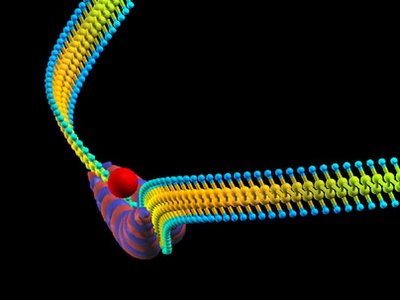Faster Fast Robot Muscles
Cathryn M. Delude, News Office Correspondent
MIT researchers, led by Professor Sidney Yip, have proposed a new theory...
Currently, robotic muscles move 100 times slower than ours. But engineers using the Yip lab's new theory could boost speeds -- making robotic muscles 1,000 times faster than human muscles -- with virtually no extra energy demands and the added bonus of a simpler design. This study appears in the Nov. 4 issue of the journal Physical Review Letters.
...a robotic muscle refers to a device that can be activated to perform a task, explains Yip, a professor of nuclear engineering and materials science and engineering.
Conjugated polymers can actuate on command if charges can be sent to specific locations in the polymer chain in the form of "solitons" (charge density waves). A soliton, short for solitary wave, is "like an ocean wave that can travel long distances without breaking up," Yip adds.
 Here, a soliton (blob with red and blue stripes) moves along a conducting polymer chain (aqua and yellow for hydrogen and carbon). The soliton blob causes a localized bend in the chain. The traditional way to make polymer actuate is to dope the material with an ion such as sodium, represented by the red dot.
Here, a soliton (blob with red and blue stripes) moves along a conducting polymer chain (aqua and yellow for hydrogen and carbon). The soliton blob causes a localized bend in the chain. The traditional way to make polymer actuate is to dope the material with an ion such as sodium, represented by the red dot.
MIT closes in on bionic speed - MIT News Office
MIT researchers, led by Professor Sidney Yip, have proposed a new theory...
Currently, robotic muscles move 100 times slower than ours. But engineers using the Yip lab's new theory could boost speeds -- making robotic muscles 1,000 times faster than human muscles -- with virtually no extra energy demands and the added bonus of a simpler design. This study appears in the Nov. 4 issue of the journal Physical Review Letters.
...a robotic muscle refers to a device that can be activated to perform a task, explains Yip, a professor of nuclear engineering and materials science and engineering.
Conjugated polymers can actuate on command if charges can be sent to specific locations in the polymer chain in the form of "solitons" (charge density waves). A soliton, short for solitary wave, is "like an ocean wave that can travel long distances without breaking up," Yip adds.
 Here, a soliton (blob with red and blue stripes) moves along a conducting polymer chain (aqua and yellow for hydrogen and carbon). The soliton blob causes a localized bend in the chain. The traditional way to make polymer actuate is to dope the material with an ion such as sodium, represented by the red dot.
Here, a soliton (blob with red and blue stripes) moves along a conducting polymer chain (aqua and yellow for hydrogen and carbon). The soliton blob causes a localized bend in the chain. The traditional way to make polymer actuate is to dope the material with an ion such as sodium, represented by the red dot.MIT closes in on bionic speed - MIT News Office

0 Comments:
Post a Comment
Subscribe to Post Comments [Atom]
<< Home